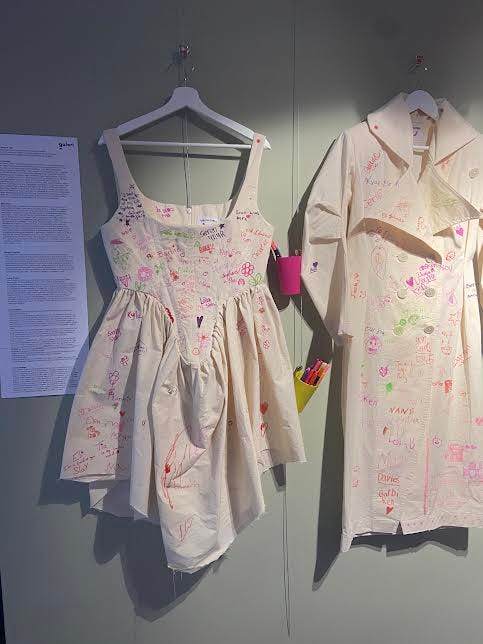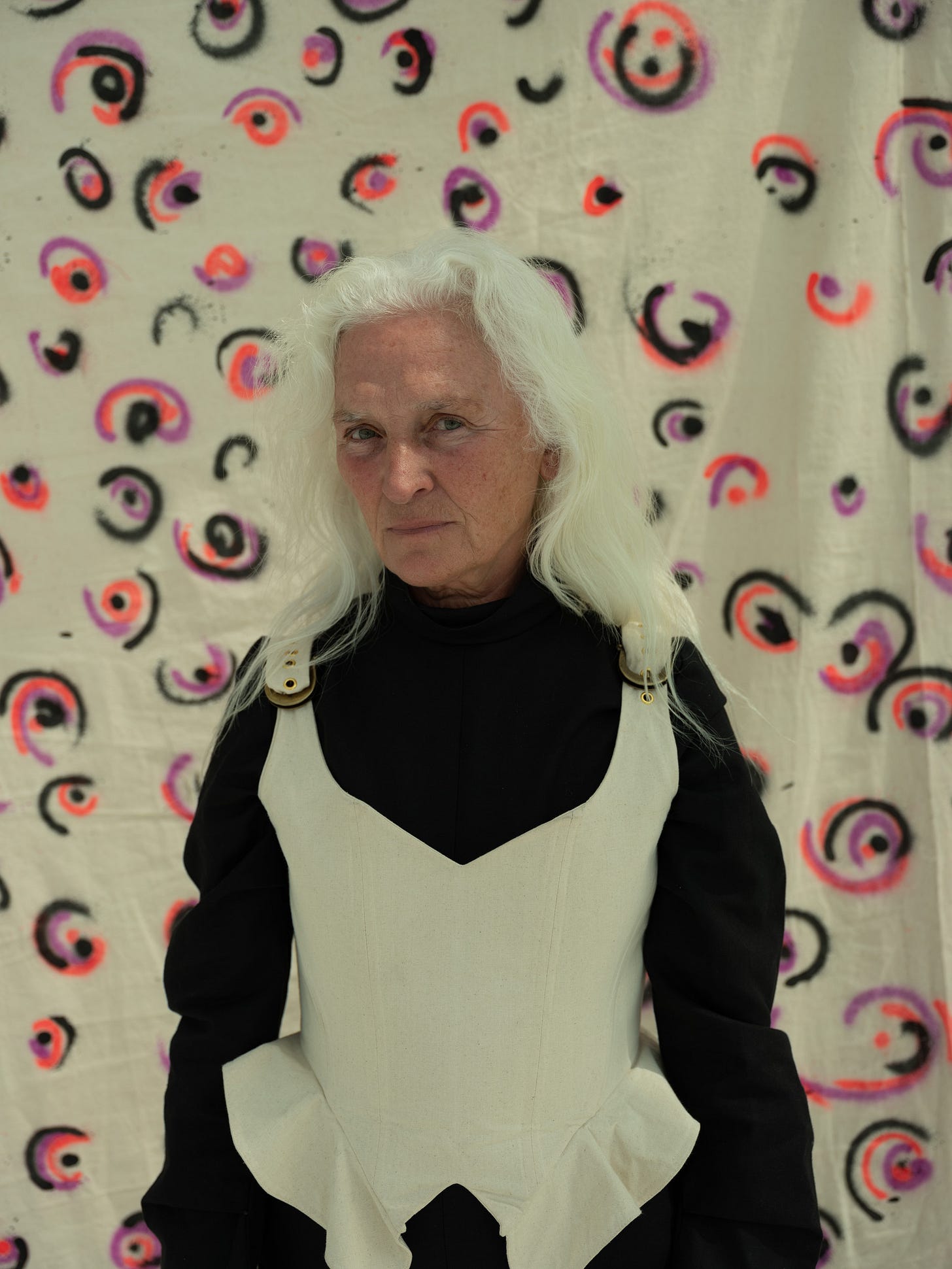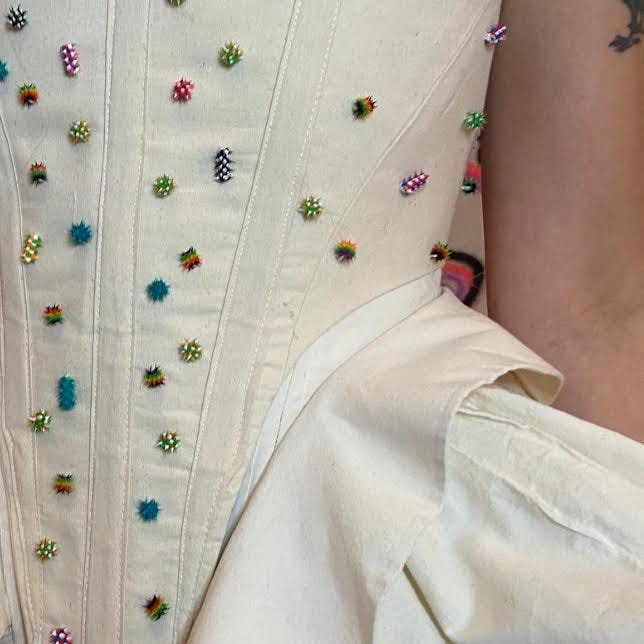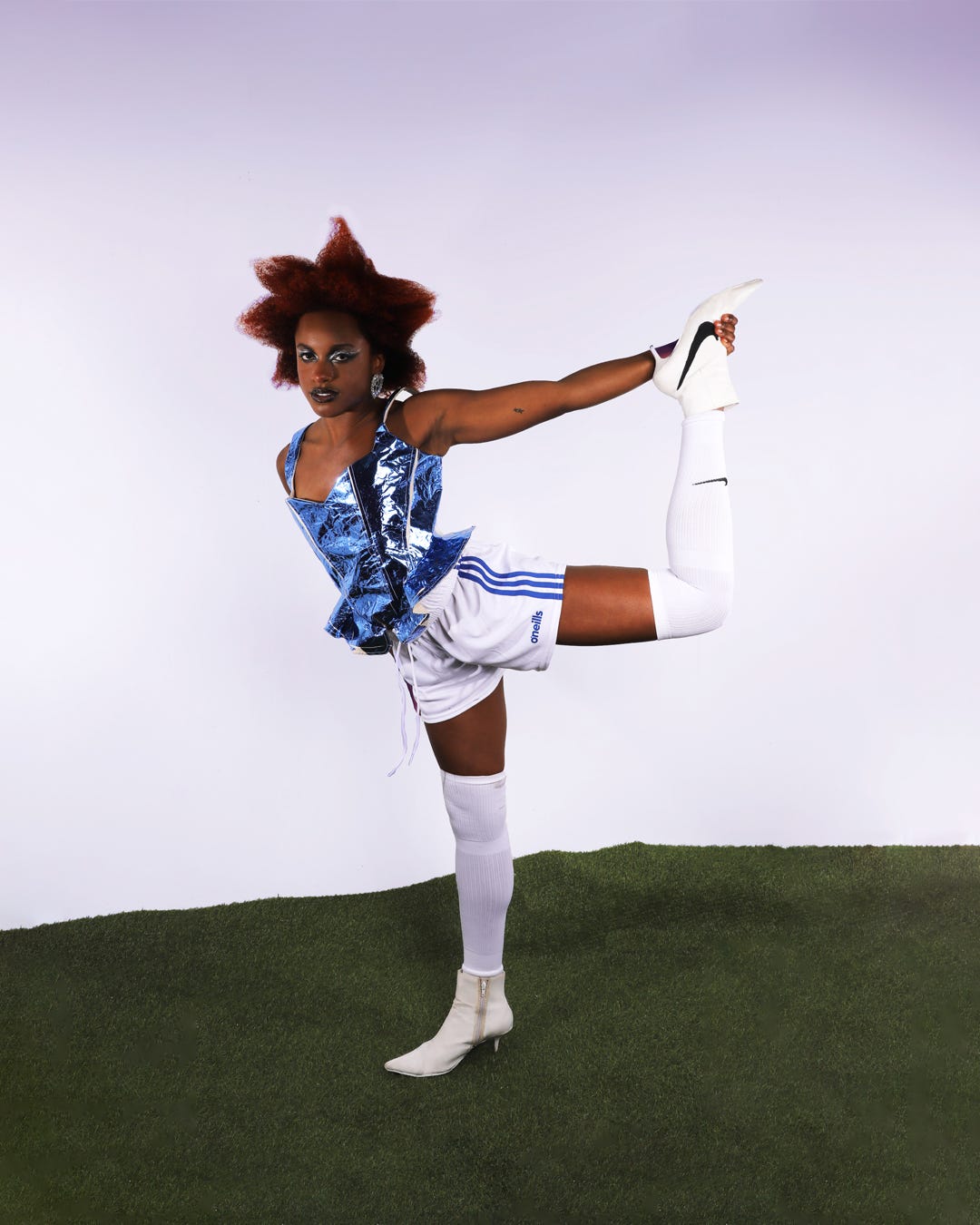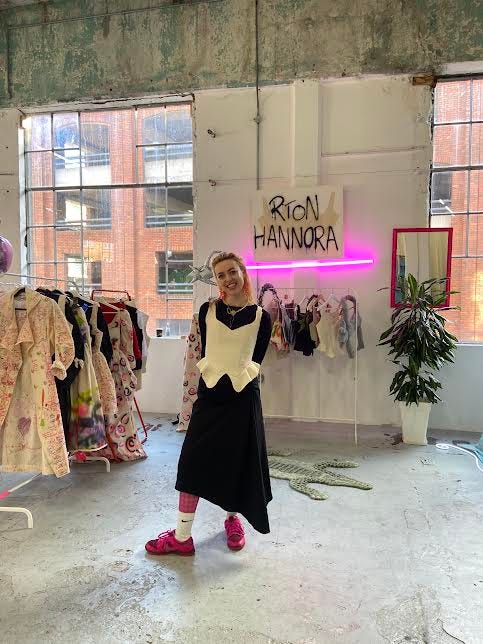I first met Ríon when I used to work in Indigo&Cloth where she’d be running up and down the stairs assisting on photoshoots. I always thought, ‘Woah, Ríon’s clothes are pretty cool, I wonder where they’re from’. My colleague later told me that Ríon makes and sells her pieces under her namesake label. The penny dropped.
It is every designer’s ambition to create a distinctive style where you say, ‘Oh yeah that looks like one of Ríon’s pieces’. This is something Ríon has achieved with her pieces, when you see them, you know it’s Ríon. She flips the script on traditional garments like dresses and corsets with vibrant motifs and textured fabrics. But not only is her work beautiful to see and feel, but in most cases completely up-cycled, reinvigorating old fabrics to make new pieces.
The Cork natives’ work is stocked in some of our best stores here in Dublin (Om Diva, Indigo&Cloth, Beautiful South), with another stockist in Wales. Along with being stocked in stores, you may have also seen various artists and DJs like Orla Gartland, CMAT, Eliza Rose and Olwen Fouéré donning her pieces.
When I asked Ríon about next steps, she had her eyes set on London Fashion Week. The minimum designers need are 6 stockists before LFW will even consider you, and as she said ‘Only 2 more to go!’
For Care Label #7, we caught up in her studio which is located above Om Diva on Drury St. We talked all things corsets, imposter syndrome and her 1960s Debs Dress made by her great-great-grandmother.
Care Label: OK Ríon, as this is a space about clothes and the stories behind same, I want to hear about your first clothing memory.
Rion: “One of my first memories is always wanting to wear this pink party dress that I wanted to wear every day. My family would only let me wear it when I was going to parties. So if anyone was having a birthday party, I'd be SO excited to wear it. I actually remember the moment that I grew out of it and I was heartbroken.”
Care Label: Tragic! And what about how you started on this path of fashion and making?
Ríon: “I can't remember. There was never a moment or anything where I said, ‘Oh, I want to be a fashion designer’. But my granny was an amazing dressmaker and so was her Mother. For my Debs, I wore a dress that my Great Granny made. It was made in the 1960s.”
Care Label: Wow, that's amazing. Most people for their Debs get the dress or tux rented. At that age, it’s very much about conforming and blending in. But no, Ríon is out here wearing her Great-Grandmother’s dress! I Love it.
*Ríon X 100’s of People*
Care Label: What about your most important possessions? This might have been something you’ve made or something you own. But what does Ríon cherish above everything else?
Ríon: “I did an exhibition in Wales and I hung this dress up in the reception area of the gallery next to loads of pens, so you could draw or write on it. Also, small kids could only reach so far, so the messages get more sophisticated as you go up the dress. So this piece is so special. It's one of my favourite things that I've worked on, but it was also a collaboration with hundreds of people!”
*Chapters of the Same Book*
Care Label: You mentioned that you were introduced to this world through your family. But something I always ask is the ‘Why’ behind the making. So why is it important to you to design or to make?
Ríon: “To be honest, I still don't know why. When I was younger, I remember making a t-shirt on my kitchen floor and just cutting straight into the fabric. I was always buying fabric as a teenager and trying to make things. My Mom used to have to hide the scissors from me because I'd always be cutting up my clothes. I don't know why I do it, I just can't stop!”
“But on a more serious note, I really don't agree with a lot of the fashion industry. So it’s hard to be part of something that I don't agree with. With my brand and work, I try and do things a bit differently in terms of bringing out ‘seasons’. I don't really agree with that. That's why I refer to my work as ‘Chapters’ rather than seasons because I want to see my work as being different chapters of the same story.
Care Label: That is great. I find the word ‘Fashion’ is similar to what you’re saying about seasons. Fashion means, ‘IN’ or ‘OUT’ of fashion, where these powerhouse companies are all racing against each other. In that world, it is far less about product and more about trends, sales and revenue.
Ríon: “Yeah and it is the idea of fashion seasons always needing to be new. Prada or YSL have so many collections a year. It doesn't make any sense. There's Pre-Fall, Resort, Cruise etc. It used to be SS and AW. And now there are 17 different collections a year! So being able to feel that my collections are all the same is why I call them Chapters.
*Struggles*
Care Label: It’s always interesting to ask what people struggle with. It helps give some appreciation for the maker and their process. So what about the things that Ríon struggles with?
Ríon: “I definitely get very bad impostor syndrome. I'm always saying ‘I’m not a fashion designer.’ I’m just up in my studio making things. Also, every time someone says, ‘Oh, what do you do?’ I'm really embarrassed by saying, ‘I’m a fashion designer’ because I don't feel like I fit into that category. I was really embarrassed that I wanted to do fashion or wanted to study it. When I was younger I’d say;
Young Ríon: ‘Oh for fuck sake why do I need to study fashion?’
“But I always thought a fashion student just reads Vogue from cover to cover. And I’d buy Vogue as a teenager because I thought this was what I was supposed to do. So when I went to study fashion I learned that it’s not about Vogue at all. It's pattern drafting, cutting, sewing etc. So when I went to study fashion, obviously I realised that it wasn’t about Vogue at all. That’s when it started to make sense when I was actually making things all the time.
Care Label: The imposter syndrome is an interesting one. I was at a District Magazine panel discussion recently where artist Leah Hewson spoke about imposter syndrome and she said that ‘Imposter syndrome is the growth. That’s when you are growing, even though it feels like you’re going backwards.’
But going back to what you said, do you think part of that imposter syndrome and embarrassment is doing this type of work in Ireland?
Ríon: “Definitely. I get the Irish eye that we all know, ‘Oh, isn't she great? She thinks she's a fashion designer.’ When I decided to give up the day job, I said to a few of my friends and family at the time;
Ríon: ‘I think I'm gonna quit my job to pursue my dreams’
Friends and Family: ‘Don't do that!’
Ríon: But I decided, NO, I’m quitting my job to pursue my dreams. And I felt so guilty at the time. There was a pang of Catholic guilt even though I'm not even baptised!”
Care Label: Moving on from the Catholic guilt…The corset is a constant in your work. I was reading up about corsets and they have a colourful history. They were quite a socially charged garment in terms of what they stood for in society and they’ve been worn by women for millennia. So why corsets?
Ríon: “I'm fascinated by them and I think they're so beautiful. By themselves, they’re pieces of art. I think the ideas behind them are really interesting. They’re very culty. But as we all know, women’s bodies and their shapes came in and out of style. When people were wearing corsets, women wanted to have tiny waists and big hips to have that hourglass silhouette. But they were instruments of torture. Women were passing out and dying because their corsets were so tight. Women also used to have their bottom ribs broken so they could fit into corsets to achieve that silhouette.”
“A lot of the corsets I make are 100% adjustable. So someone who's a size 8 or a size 14 could wear the exact same piece. People are always very appreciative because of how they feel when wearing them. Denice Chaila said once that it was like wearing a weighted blanket. She said that she felt so held. Having them as an item of comfort excites me. It's just like that complete contrast is so interesting to me.”
Care Label: I might be reaching at something here, but corsets were always seen as a sign of obedience for Women. So are you turning the corset on its head a bit by making them comfortable, but making the wearer feel and look good too?
Ríon: “Totally. It’s empowerment. It’s something that has traditionally been restrictive, but I make them for people to be comfortable. Making people feel good through clothing is the goal of why I do what I do. For anyone to say ‘I felt so amazing wearing that’. I'm like, perfect, my job is done.”
*Clothing for All*
Care Label: You spoke on how your pieces empower people, but what excites you most about making clothes for people to wear?
Ríon: “I think it's really important for my work to be accessible to everyone. I think I realised recently that in my previous Chapters, my customer was mainly people my own age. But then I started being stocked in Beautiful South in Rathmines. Grainne’s customers would be older than the people who’ve bought my pieces previously. So we designed a few pieces together. A lot of that collection then was mainly aimed towards an older customer, which I liked. I really really love it when older people buy my stuff. I did a shoot with Olwen Fouéré. She's honestly amazing. Her hair and her skin tone were so beautiful at the time.”
*Making it Happen*
Care Label: You, along with others just put on Independent Fashion Week (IFW) here in Dublin. This was an opportunity for various Irish makers to showcase their work all under one roof which is something that is greatly missing here in Dublin. What sparked you to do it?
Ríon: “I guess just not having the space was super annoying for all of us. We as makers do all these shoots and posts for Instagram, but there’s an unrewarding feeling that comes with that. It is so much work for no return. You're chasing this constant rush of something I feel. It's so addictive, and it's so horrible. So I just wanted somewhere to show my work in real life and for people to come in to chat and be able to try things on. It’s daunting for people to come up to my studio to see my work, which I do, but that's so intimate, and it doesn't have to be that way.”
“So rather than waiting around for someone else to do it, we just took it upon ourselves. It took a lot of work and I slept for about a week after it! But it was so rewarding. It was the complete opposite of posting a picture on Instagram. A big part of it was just people appreciating Irish design and people realising that there's so much talent and so much fresh work here. They don't make it easy to be creative in Ireland, especially with rents, it's financially very, very difficult. So it makes sense when people leave Ireland to pursue their creative interests overseas. All that talent is lost, which is terrible.”
*Cork City Meets London Fashion Week*
Care Label: In terms of next steps and success. What's next for Ríon?
Ríon: “I don't know. I really don’t know. I love Ireland and I love my stockists and customers, but I would love to show at London Fashion Week. In terms of success, I mean, being content with your work is a success. Also, being able to feed yourself! That’s always good…. But also consistency. So as long as there's consistency, I think that's also being happy with what you're producing.”
Care Label: Amazing, that’s it. Thanks, Ríon.






